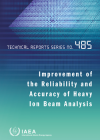Ion beams are created when charged particles are accelerated. The IAEA supports their use for research on the effects of radiation on materials and in the development of applications for materials analysis.
Ion beams
The applications of ion beam accelerators can be divided into two broad areas: analytical methods to identify the elemental and isotopic composition and the structural state of materials; and the modification of materials.
Some ion beam analytical techniques rely on stimulating radiation to be emitted from the sample, for instance the PIXE (particle-induced X-ray emission) and NRA (nuclear reaction analysis) methods, which are sensitive to the chemical or isotopic composition of materials. Other techniques utilize the scattering and recoil of the ions from the sample to characterize the chemical and structural makeup of materials or to obtain elemental concentration depth profiles.
Analytical methods can be used to
- determine the origin of pollutants such as fine aerosols in air or sediment particles transported by water;
- characterize contaminants in food;
- image individual biological cells; and
- determine trace element distribution in tissues and the mechanisms of disease.
Ion beam methods can also be used to analyse in a non-destructive way cultural heritage items. The composition of inks, paints and glazes on ceramics and glasses can be examined to determine where works of art or archaeological artefacts come from. The method can also reveal whether an article is fake or genuine; whether it has been altered in the past; what mechanisms of corrosion and deterioration have been at work; and how affected artefacts can be preserved.
In the field of materials' modification, ion beams find applications in
- nanotechnology, such as the creation of nanofabricated structures;
- semiconductors and electronic devices, for instance by ion implantation; and
- DNA modification, for instance mutagenic breeding of plants.
They are also useful to conduct fundamental studies of the interactions between radiation and materials. Many advanced reactor concepts would generate large fluxes of neutrons with energies much higher than current generations of reactors. These fast neutrons fluxes do far more damage to materials in the reactor, such as the cladding that surrounds nuclear fuel. Gases produced by nuclear reactions can exacerbate swelling of the cladding. Energetic ion beams can be used to accelerate the rates of damage to such materials to rates that greatly exceed those achievable in a test reactor. And, by simultaneously applying two more ion beams, hydrogen and helium gases can be produced inside the material. Therefore, all major damage processes that occur within a reactor can be simulated with ion beams, providing a rapid screening of potential candidate materials.
A global list of ion beam accelerators can be found on the IAEA's Accelerator Knowledge Portal.






